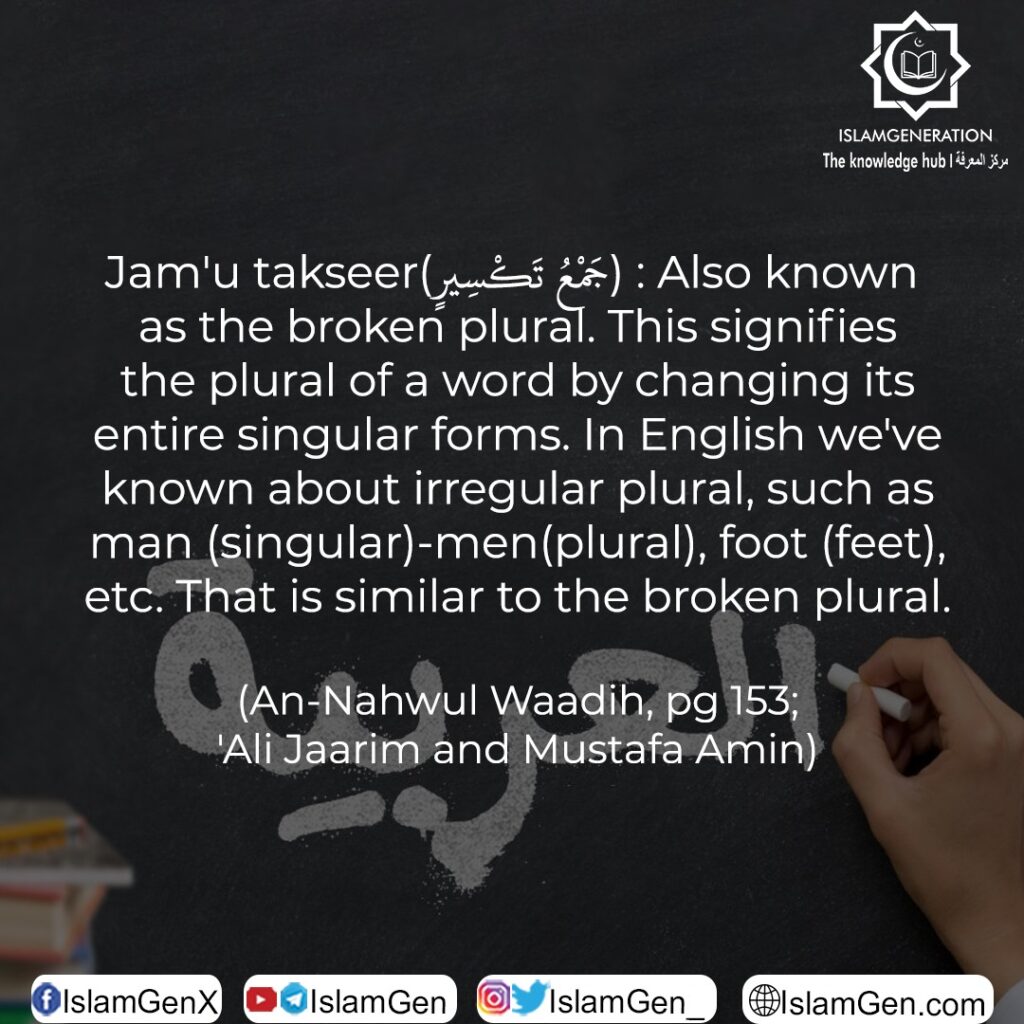﷽
EPISODE 7⃣- PLURAL

From the last episode, we could see that the jam’u (plural) appeared to be quite different from the singular in some cases. Whereas in the English language, most plurals are determined by the addition of “s” or “es”, most plurals of Arabic language are dependent on the gender of the subjects of the sentences.
The plural is divided into three:
- Jam’u takseer (جَمْعُ تَكْسِيرٍ): also known as the broken plural. This signifies the plural of a word by changing its entire singular forms.
In English we know about irregular plurals, such as man (singular) – men (plural), foot (feet), etc. That is similar to the broken plural.
E.g العَامِلِ (s) – العُمَّالُ (p) - Jam’u mudhakkar as-saalim (جَمْعُ المُذَكَّرِ السَالِمُ): this signifies the plural of a word by the addition of Waw and Noon (ون) or Yaa and Noon (ين) at the end of the words. This form of jam’u is used for masculine words. E.g البَائَغ (s) – البَائَعُونَ (p)
- Jam’u mu’annath as-saalim (جَمْعُ المُؤَنَثِ السَالِمُ): this signifies the plural of a word by the addition of Alif and Taa (ات) at the end of the words. This form of jam’u is used for feminine words. E.g
شَجَرَة (s) – شَجَرَات (p)
Examples:
١. قَرَأْتُ الكُتُبَ
(qara’tul kutub)
- I read the books
٢. تَعِبَ اللَّاعِبُونَ
(Ta’iba al-laa’ibun)
- The players are tired
٣. ذَبَحْتُ الدَّجَاجَاتِ
Dhabahtu ad-dajajat)
- I slaughtered the hens
The last word (noun) in the first sentence is plural, and if we study the singular form, we can see the contrast between the singular and the plural form. We see that the structure of the word changed in the plural form. The singular of كُتُبٌ is كِتَابٌ i.e kutub (p), kitaab (s). This form of plural is known as the broken plural.
In the second sentence, the last word is a plural too. And if we look closely at the singular form of the word, we observe that its root word is the singular form with just the addition of waw and noon (ون), or yaa and noon (ىن). The singular of لَاعِبُونَ is لَاعِبٌ i.e Laa’ib (s), Laa’ibun (p).
This form of plural is known as the sound masculine plural.
In the third sentence, the last word is also a plural. And if we look closely at the singular form of the word, we observe that its root word is the singular form with just the addition of Alif and Taa (ات) at the end. The singular of دَّجَاجَات is دَجَاجَة i.e Dajajah (s), Dajajaat (p). This form of plural is known as the sound feminine plural.
The plurals are easy to identify, especially those that are extended forms of the singular words.
May Allāh (ﷻ) make it easy for all of us, and may He (ﷻ) bless us with the understanding of the Arabic language.
==============================
🕋 ISLAM GENERATION DA’WAH GROUP
For more Islamic reminders, check out:
WhatsApp:
https://chat.whatsapp.com/CNvocRvZHnZFZkbUuXUK8J
Telegram: https://t.me/IslamGen
YouTube: https://youtube.com/IslamGen
Website: https://www.IslamGen.com
Twitter: https://twitter.com/IslamGen_
Instagram: https://instagram.com/IslamGen_
Facebook: https://facebook.com/IslamGenX





